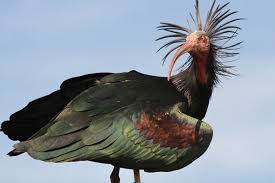
After centuries of decline, the Northern Bald Ibis, a species once believed to have vanished, is experiencing a remarkable resurgence in Europe thanks to concerted conservation efforts. This bird, recognized for its glossy plumage and distinctive curved beak, had been absent from the continent for over three hundred years. In ancient cultures, it held significant symbolic value, even having a hieroglyph dedicated to the word “spirit.”
Decline and Near Extinction
By the late 20th century, the Northern Bald Ibis faced near extinction, dwindling to just 59 breeding pairs in Morocco due to human activities such as hunting, habitat destruction, and pesticide use. However, dedicated conservation initiatives in Morocco have led to a significant recovery. As reported by CNN, the establishment of the Souss-Massa National Park in 1991 provided essential protection for the bird’s breeding and feeding habitats. A research program launched in 1994 monitored the population, which has since grown to over 500 individuals in the wild. The International Union for Conservation of Nature (IUCN) has even downgraded the bird’s status from “critically endangered” to “endangered.”
Successful Conservation in Morocco
The Moroccan population of Northern Bald Ibises, which primarily prefers to nest in cliffs and urban ruins, has stabilized due to these conservation efforts. The birds are adaptive foragers, primarily feeding on insects and larvae while adjusting to the changes in their environment.
Reintroduction Efforts in Europe
Despite thriving in Morocco, the Northern Bald Ibis had long been absent from its European range. Recent reintroduction projects have started to yield positive results. In Andalusia, Spain, a program initiated in 2004 has successfully reintroduced the bird into the wild, where hand-reared chicks are gradually released into their natural habitats.
In Austria and Germany, biologist Johannes Fritz has implemented a unique approach to reintroducing a migratory population. Captive-raised birds, lacking knowledge of migration routes, are guided to migrate by following an ultralight aircraft. Fritz, piloting the aircraft, helps these birds learn to navigate from Germany to southern Europe. The route has been adjusted to conclude in Spain due to environmental changes affecting traditional migratory patterns.
Ongoing Challenges
Despite these conservation successes, the Northern Bald Ibis continues to face significant challenges. Threats such as poaching, pesticide use, and climate change remain critical risks. In 2023, poaching accounted for the loss of 17 percent of migrating birds in Europe. Additionally, climate change is altering the timing of migration journeys, compelling the birds to adapt to new environmental conditions.
The revival of the Northern Bald Ibis serves as a testament to the positive impact of conservation efforts, yet it also underscores the ongoing challenges that threaten its survival in the wild. As these initiatives continue to evolve, the hope is that the Northern Bald Ibis can once again thrive across its former ranges.
Sources By Agencies


